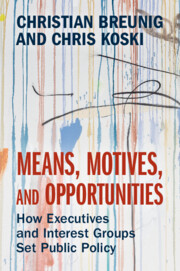Book contents
- Frontmatter
- Dedication
- Contents
- Figures
- Tables
- Acknowledgments
- Part I Setting Public Policy
- 1 Explaining One Million Policy Stories
- 2 Meeting at the Margins
- Part II Motives, Opportunities, and Means of Policy Change
- 3 Motives
- 4 Opportunities
- 5 Means
- 6 How Interests and Executives Set Public Policy in Four States with Nat Rubin
- Part III Public Policy and Budgeting in the American States
- 7 Conclusion
- References
- Index
6 - How Interests and Executives Set Public Policy in Four States with Nat Rubin
Published online by Cambridge University Press: 11 April 2024
- Frontmatter
- Dedication
- Contents
- Figures
- Tables
- Acknowledgments
- Part I Setting Public Policy
- 1 Explaining One Million Policy Stories
- 2 Meeting at the Margins
- Part II Motives, Opportunities, and Means of Policy Change
- 3 Motives
- 4 Opportunities
- 5 Means
- 6 How Interests and Executives Set Public Policy in Four States with Nat Rubin
- Part III Public Policy and Budgeting in the American States
- 7 Conclusion
- References
- Index
Summary
In this chapter, we bring together motives (issues), means (gubernatorial powers), and opportunities (interest group compositions) using qualitative case studies of four states across several years: two with strong governors (New York and West Virginia) and two with weak governors (North Carolina and Vermont). The size of the budgets in these states varies, but they entail three subcategories that correspond with capture [corrections], instability [hospitals], and deadlock [welfare]. An investigation of twelve policy stories provide evidence for the mechanisms connecting governors and interest groups in periods of budgetary change. The policy stories cover similar temporal periods (2002–2004 and 2008–2010) controlling for national political context. We show that – large or small states – governors attempt to use their powers in all policy domains, but are met with much greater resistance in capture and deadlock categories.
Keywords
- Type
- Chapter
- Information
- Means, Motives, and OpportunitiesHow Executives and Interest Groups Set Public Policy, pp. 175 - 218Publisher: Cambridge University PressPrint publication year: 2024



